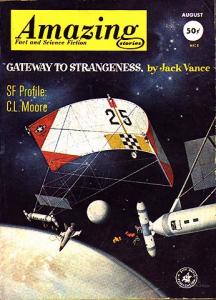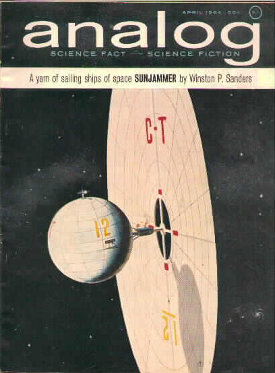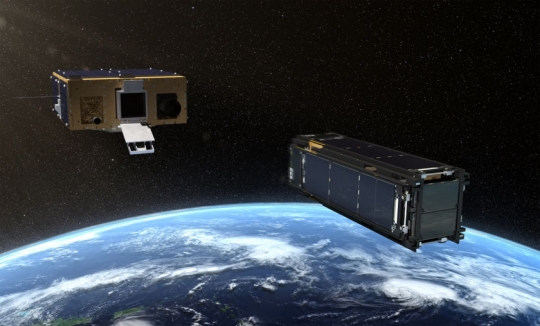Solar sails are a case of science fiction anticipating the scientific journals, though in an odd way. Engineer Carl Wiley (writing as Russell Saunders) described the physics of solar sailing and some early engineering concepts in the pages of John Campbell’s Astounding back in 1951, but he did it in a nonfiction article of the kind the magazine routinely ran. Richard Garwin would discuss sails in the scientific literature in “Solar Sailing: A Practical Method of Propulsion within the Solar System,” which ran in 1958 in the journal Jet Propulsion.
Then we waited for fictional treatments, which began with Cordwainer Smith’s wonderful “The Lady Who Sailed the Soul” (Galaxy, April 1960) and a string of stories from top authors of the time in just a few quick years — Jack Vance’s “Gateway to Strangeness” (Amazing Stories, 1962), Poul Anderson’s “Sunjammer” (Analog 1964), Arthur C. Clarke’s story of the same name, later renamed “The Wind from the Sun” (Boy’s Life, 1964). Sails of the solar kind had definitely arrived.

Because he is a personal favorite, let me run a clip from the Jack Vance story, which later became known as “Sail 25” (available in various places, but most easily in the 1976 collection The Best of Jack Vance). This is what solar sailing looked like in the days when the nautical metaphor was just beginning to be explored, and a fictional crew is learning, with the help of space veteran Henry Belt, to handle the unusual demands of sail deployment.
“Around the hull swung the gleaming hoop, and now the carrier brought up the sail, a great roll of darkly shining stuff. When unfolded and unrolled, and unfolded many times more it became a tough gleaming film, flimsy as gold leaf. Unfolded to its fullest extent it was a shimmering disk, already rippling and bulging to the light of the sun. The cadets fitted the film to the hoop, stretched it taut as a drum-head, cemented it in place. Now the sail must carefully be held edge on to the sun, or it would quickly move away, under a thrust of about a hundred pounds.
“From the rim braided-iron threads were led to a ring at the back of the parabolic reflector, dwarfing this as the reflector dwarfed the hull, and now the sail was ready to move.
“The carrier brought up a final cargo: water, food, spare parts, a new magazine for the microfilm viewer, mail. Then Henry Belt said, ‘Make sail.'”
It sounded complicated in 1962, but in the era of the IKAROS sail, we’ve learned how tricky actual deployment is, and also how incredibly thin high-performance sails will need to be, particularly as we look toward future missions with cutting-edge materials. Geoff Landis, for example, has examined sails of niobium, beryllium and transparent films of dielectric (non-conducting) materials like silicon carbide, zirconia and diamond-like carbon — a material much like diamond — that could be assembled in space with a plastic substrate.

James Davis Nicoll recently wrote up some examples of sails in science fiction that include the early ones mentioned above, but also more recent work like the novels in Vonda McIntyre’s ‘Starfarers’ sequence and the 1974 tale “The Mountains of Sunset, the Mountains of Dawn.” Also catching Nicoll’s attention is Joan D. Vinge’s “View from a Height,” which should interest anyone exploring the human motivations for immense journeys, and Alastair Reynolds’ Revenger (2016). I hope readers will supply some of their own favorites in science fictional sails. Laser sails play a prominent role in Larry Niven and Jerry Pournelle’s The Mote in God’s Eye (1974), for example, the ‘mote’ being evidence of a sail heading in our direction. And then there’s Forward’s Rocheworld… The list is extensive!
Image: Poul Anderson’s “Sunjammer” appeared in April, 1964, about a month after Arthur C. Clarke’s story of that name, and to make matters even more confusing, ran under the pseudonym ‘Winston P. Sanders.’ Both stories were milestones in early sail depictions.
Like Nicoll, I’m looking back at sail technologies partly because we’re coming up on the launch of The Planetary Society’s LightSail 2, which is now scheduled for no earlier than June 24 aboard a SpaceX Falcon Heavy. The CubeSat spacecraft about the size of a loaf of bread and weighing 5 kilograms will deploy a small sail and attempt to raise its orbit by the momentum imparted by solar photons. I’m a great partisan of CubeSats, particularly those with sail capabilities, for fleets of the inexpensive spacecraft, further miniaturized, networked and tapping solar radiation, can become a great way to deploy sensors all through the inner system.
LightSail is no 5,000-mile behemoth, like the staggering sail of Cordwainer Smith’s story — its four booms will unfurl four triangular panels with a combined area of 32 square meters, and as The Planetary Society’s Jason Davis tells us, the craft will receive a push ‘no stronger than the weight of a paperclip.’ But continual thrust is just the ticket as the effects mount up, and LightSail 2 will be in an orbit high enough (720 kilometers) that the effects of atmospheric drag can be overcome. Expect LightSail 2 to be deployed from the Prox-1 spacecraft that encloses it about seven days after launch. All good wishes on the attempt!

Image: Prox-1 deploys the LightSail 2 spacecraft in Earth orbit. Credit: The Planetary Society (CC BY-NC 3.0).



It’ll be interesting to see which comes ahead in the “solar powered slow acceleration” engine category: solar sails or solar-electric propulsion.
My first exposure to solar sails was in James Lovelock’s Greening of Mars, where the narrator talks about how solar sail ships brought a lot of the colonists to Mars.
“LightSail is no 5,000-mile behemoth … its four booms will unfurl four triangular panels with a combined area of 32 square kilometers…”
Please tell me that’s not a typo?
Thanks for catching this. Good grief…
32 square kilometers? We’re further along than I thought! :)
Typos make the world more interesting! Anyway, now fixed.
LightSail total area = 32 square meters not 32 square kilometers surely?
Yes, my fault, a typo that I’ve now corrected. Thanks for snagging it.
And don’t let us ever catch you doing it again!!!
Let’s hope not! ;-)
On the contrary, let us catch typos wherever they occur! But let Paul provide us with vanishingly few opportunities!
I have followed the progress of The Planetary Society and its development of lightsail one and two and while I wish them well it appears progress has passed them by. Ikaros has already demonstrated interplanetary solar sailing and the advent of diffractive solar sails and the promise of solar electric sails means this technology will soon be obsolete.
I recall reading he story about fearsome solar sailor Harry Belt (you wrote ‘Henry’ in the quote), but couldn’t recall the author’s name: Jack Vance. Terrific short story! Anyway, good luck to the P. Society.
Greg Benford’s short story, “The Man Who Sold the Stars”, has a hybrid beamed sail/ion engine ramjet Sundiver XI. Published in Starship Century after the conference of the same name. It is a robotic explorer probe to a nearby brown /red dwarf star.
Good one. I loved that story and, of course, the nod to Heinlein.
It is interesting that LightSail 2 will orientate itself with a momentum wheel. I am guessing this is much cheaper than the LCD panels on IKAROS, but also more likely to fail in the long term.
CD had a nice post about building huge, low aerial density solar sails, updating Eric Drexler’s original idea for building solar sails in space. Some sort of demonstration projects to build these sails and how to control them would be interesting.
Building Vast Solar Sails in Space The book Project Solar Sail is mentioned, which includes a chapter on Drexler’s sail manufacturing proposal, a number of chapters interspersing fact and fiction on solar sailing. High performance solar sails are so delicate that in situ manufacturing in space seems necessary. I have to wonder whether they will need to be made in the shadows to ensure they do not get damaged during manufacture.
Project Solar Sail is still, after all this time, a wonderful reference, and the Drexler chapter in particular has been helpful to me.
John C Wright’s Eschaton Sequence(2011-2018), has the ‘nigh-to-lightspeed starship Emanicipation’. … ‘With a sail spread of five hundred miles,…’. Fantastic six book series.
A new one for me. Thanks!
On another tack (do not excuse the pun) may I be so bold as to reference the last portion of an article I co-wrote for these pages about a solar sail driven intergalactic signaling device: https://centauri-dreams.org/2016/12/21/citizen-seti/
From the article:
And now for some sci-fi.
A few months before KIC 8462852 was announced and Dyson Swarms became all the rage, I noticed one of those old ventilators on top of a barn roof and thought that if a Kardashev II civilization scaled it up to +-1AU diameter, it would become a solar powered, omni-directional signaling device capable of sending an “Intelligence was here” message across interstellar space. I called it a Dyson Shutter.
Now the question is not could such an ETI conduct such an effort, but why?
To further add on asking why an ETI would attempt contact is key to their conducting such activities at all:
https://centauri-dreams.org/2009/09/18/the-why-of-meti-and-seti/
Scientists in this field have long preferred to focus on the what and where factors because they aren’t nearly as “squishy” as why, for your standard human male born in the 20th Century in particular. We will not advance in the field until the why factor is better addressed.
Lightsail 2 launch news and viewing information from The Planetary Society blog page:
http://www.planetary.org/blogs/guest-blogs/2019/lightsail2-new-launch-date.html
http://www.planetary.org/blogs/guest-blogs/2019/lightsail-2-launch-viewing-tips.html
http://www.planetary.org/blogs/jason-davis/what-to-expect-lightsail-2.html
Hi Paul
“Revenger” is a fun read. Andrew Higgins got me on to it, and got me thinking about their cosmic location. Not plot integral, but a spoiler – I’ll let you figure it out. Pierre Boule’s “Planet of the Apes” uses an interstellar Sail, but the earliest fictional usage I know is Haldane’s “The Last Judgement” (1927) where Venusian colonists use sails for Interplanetary travel.